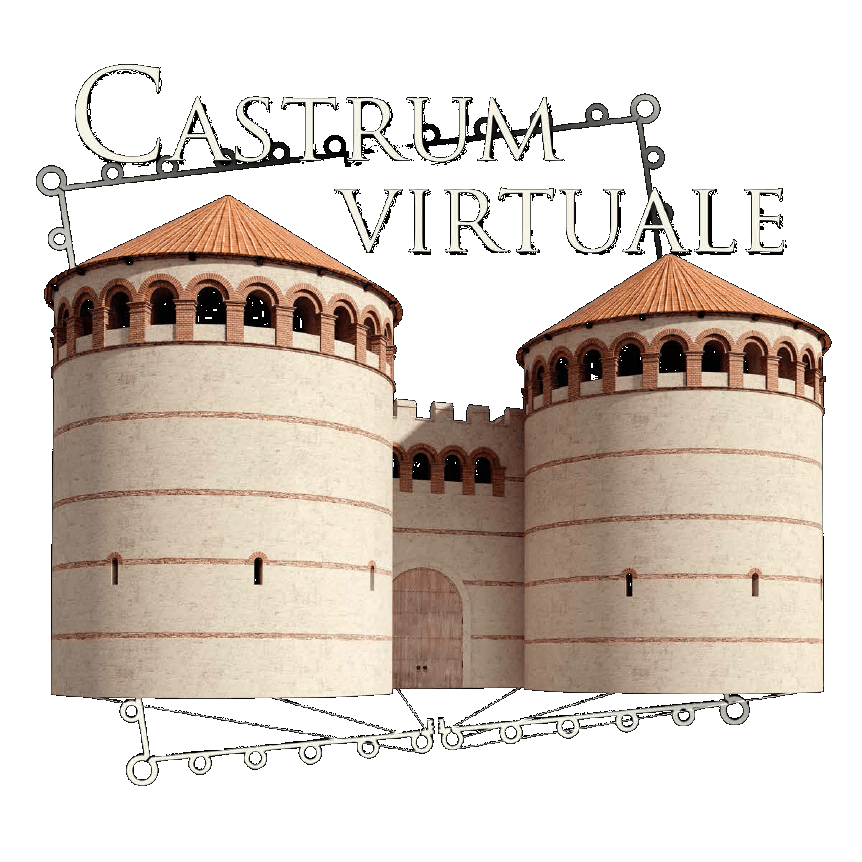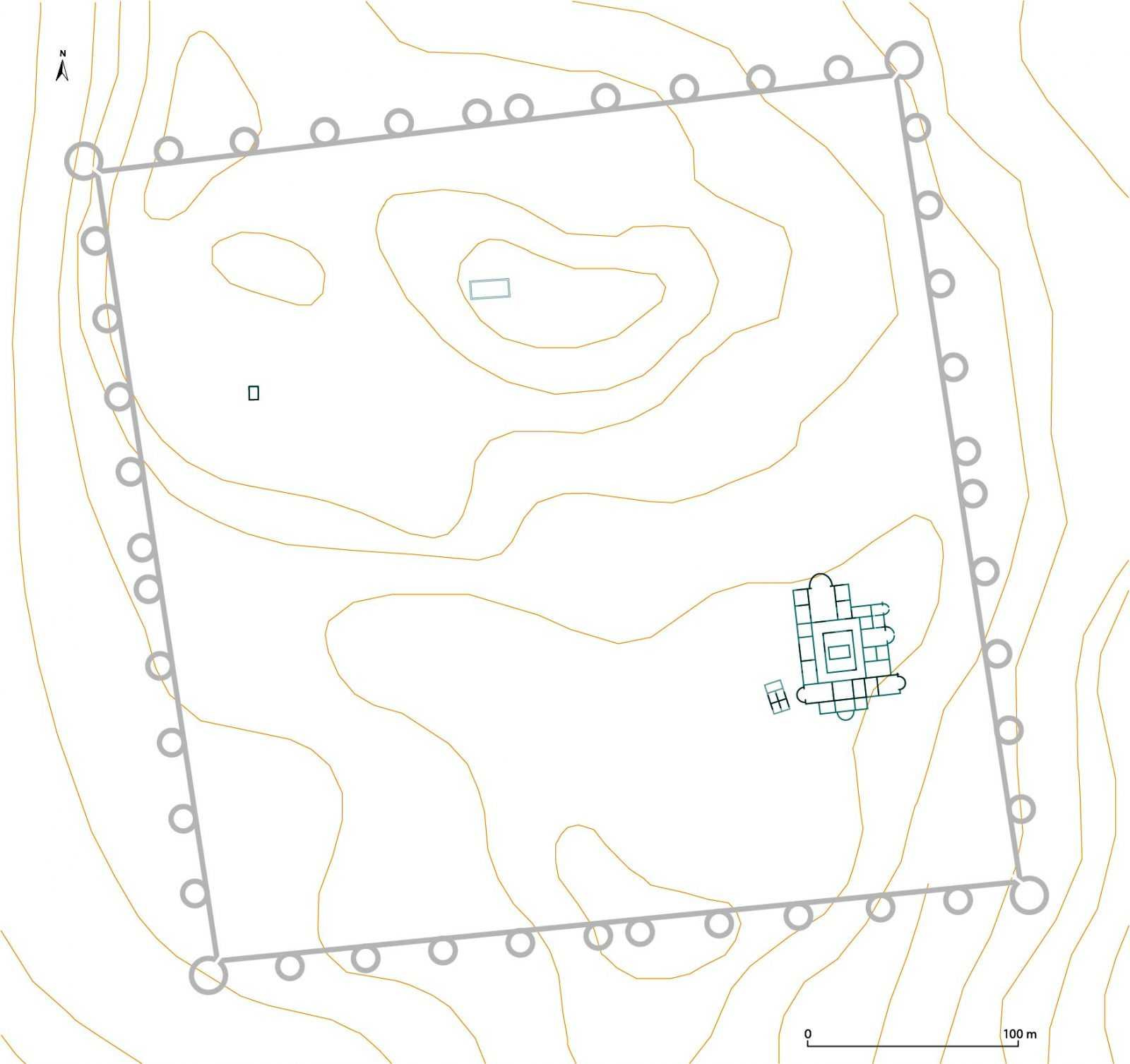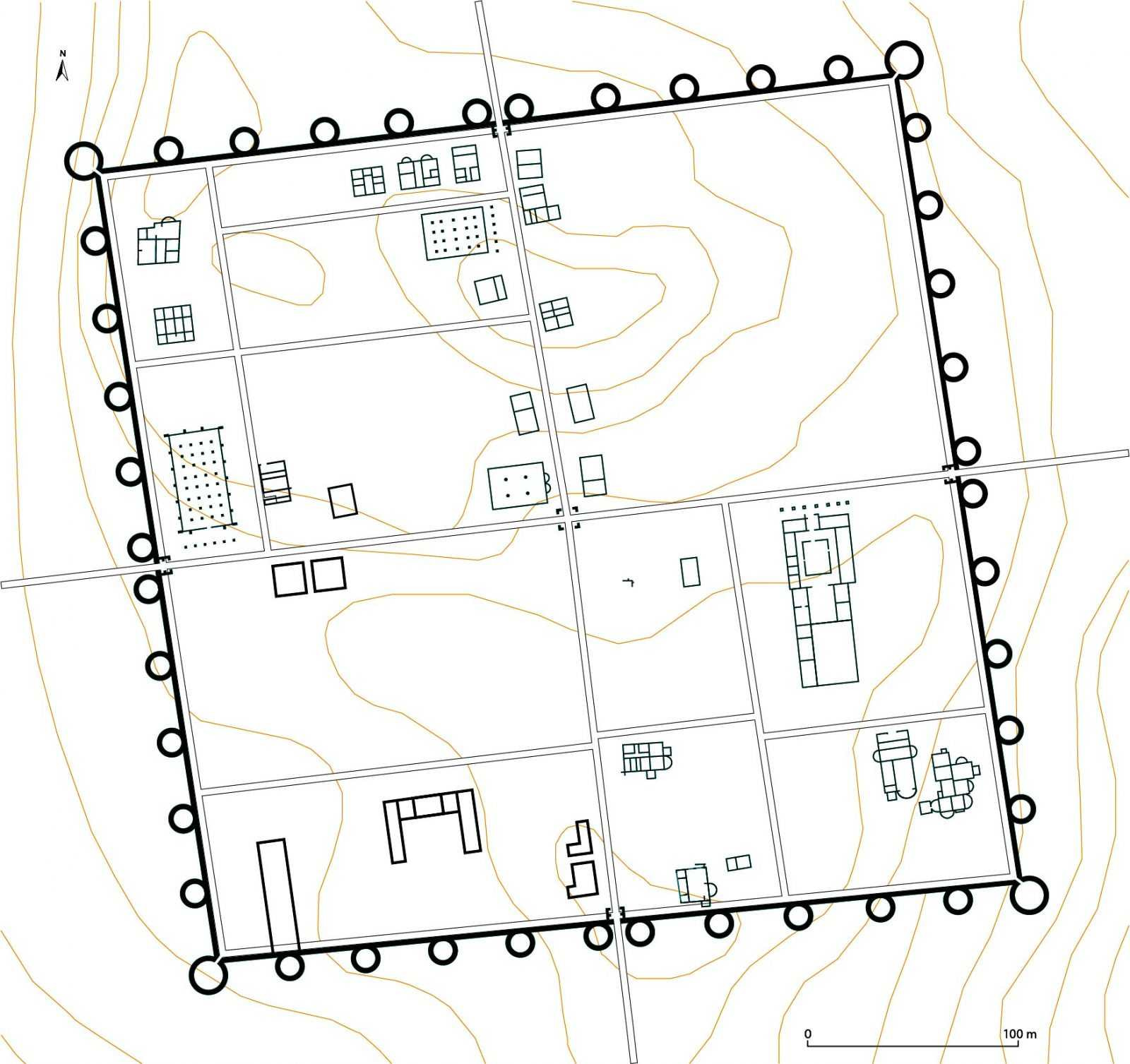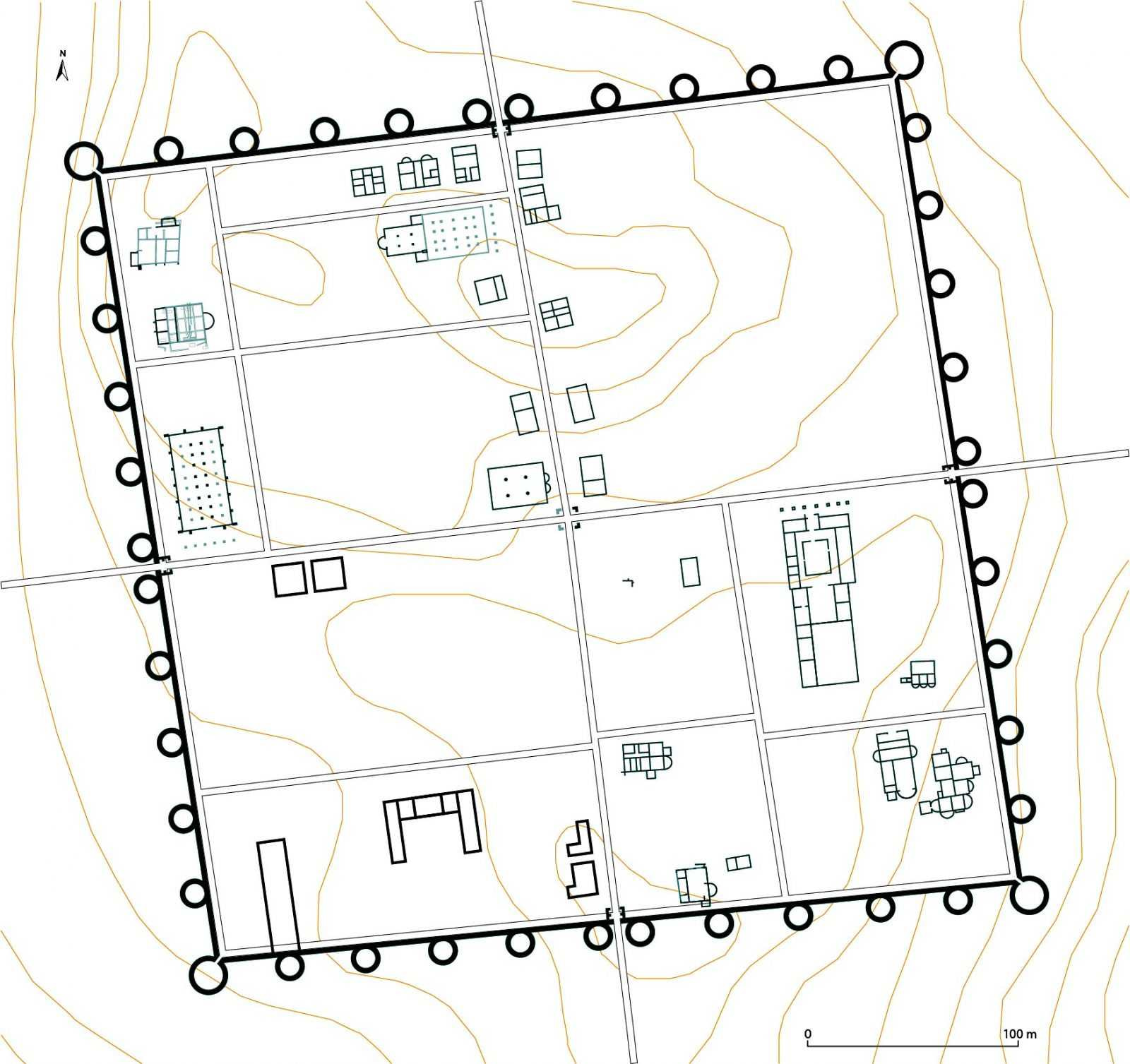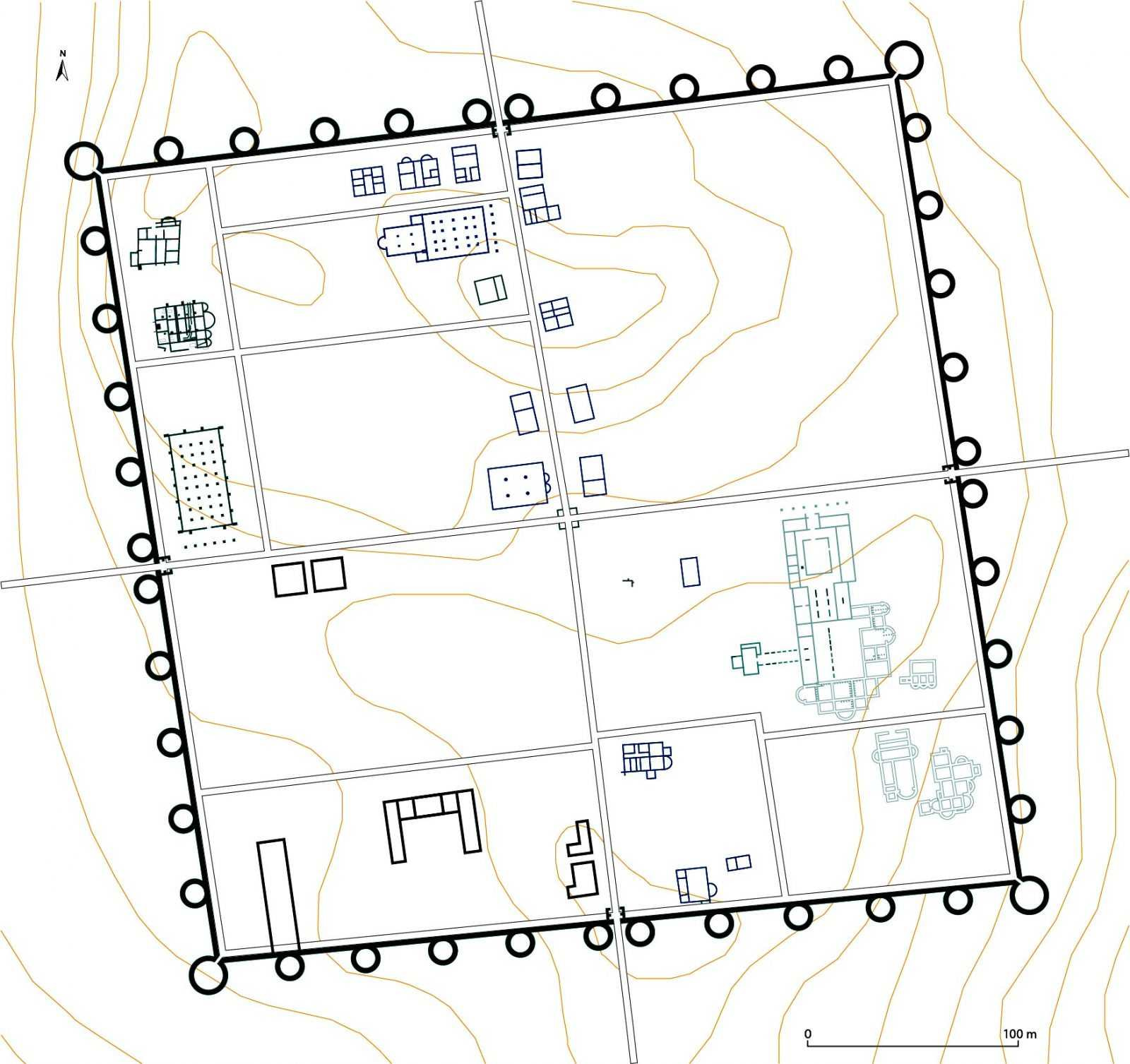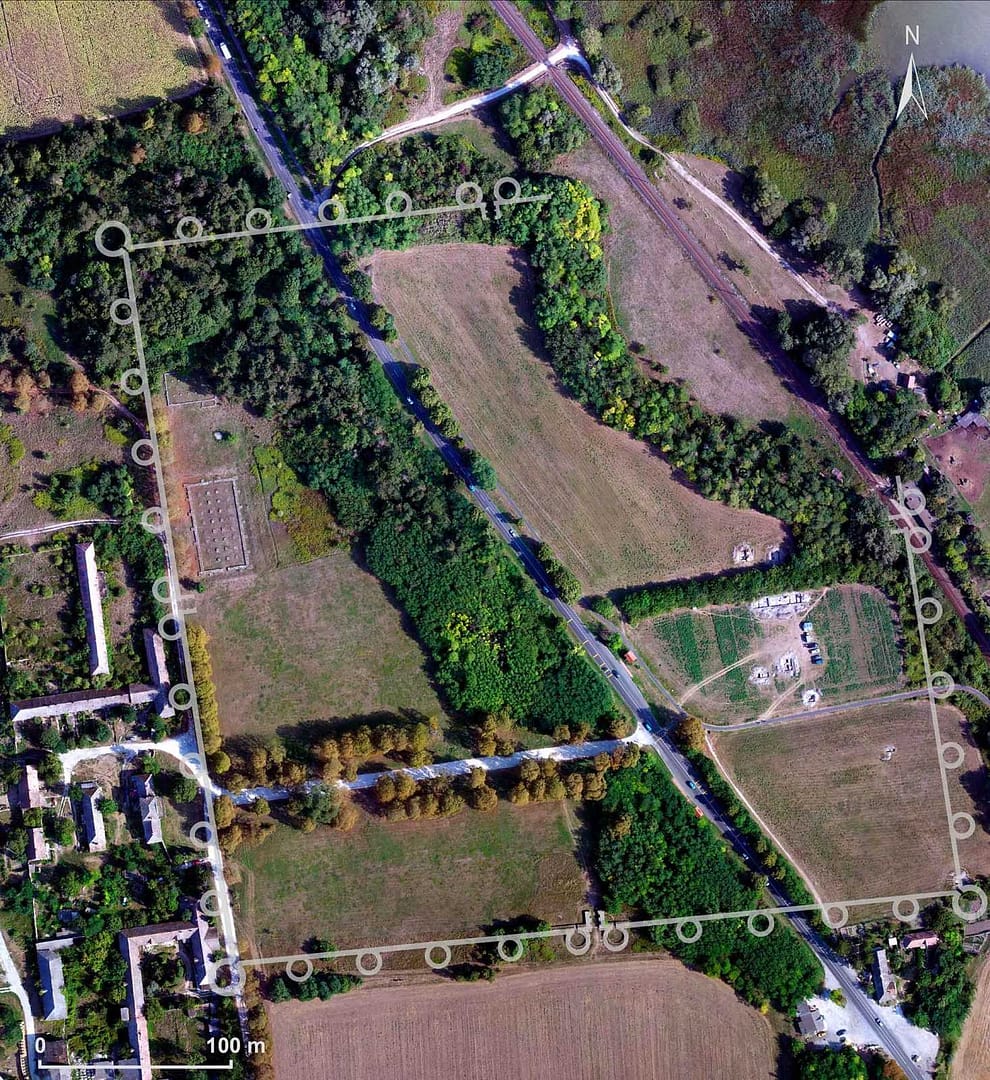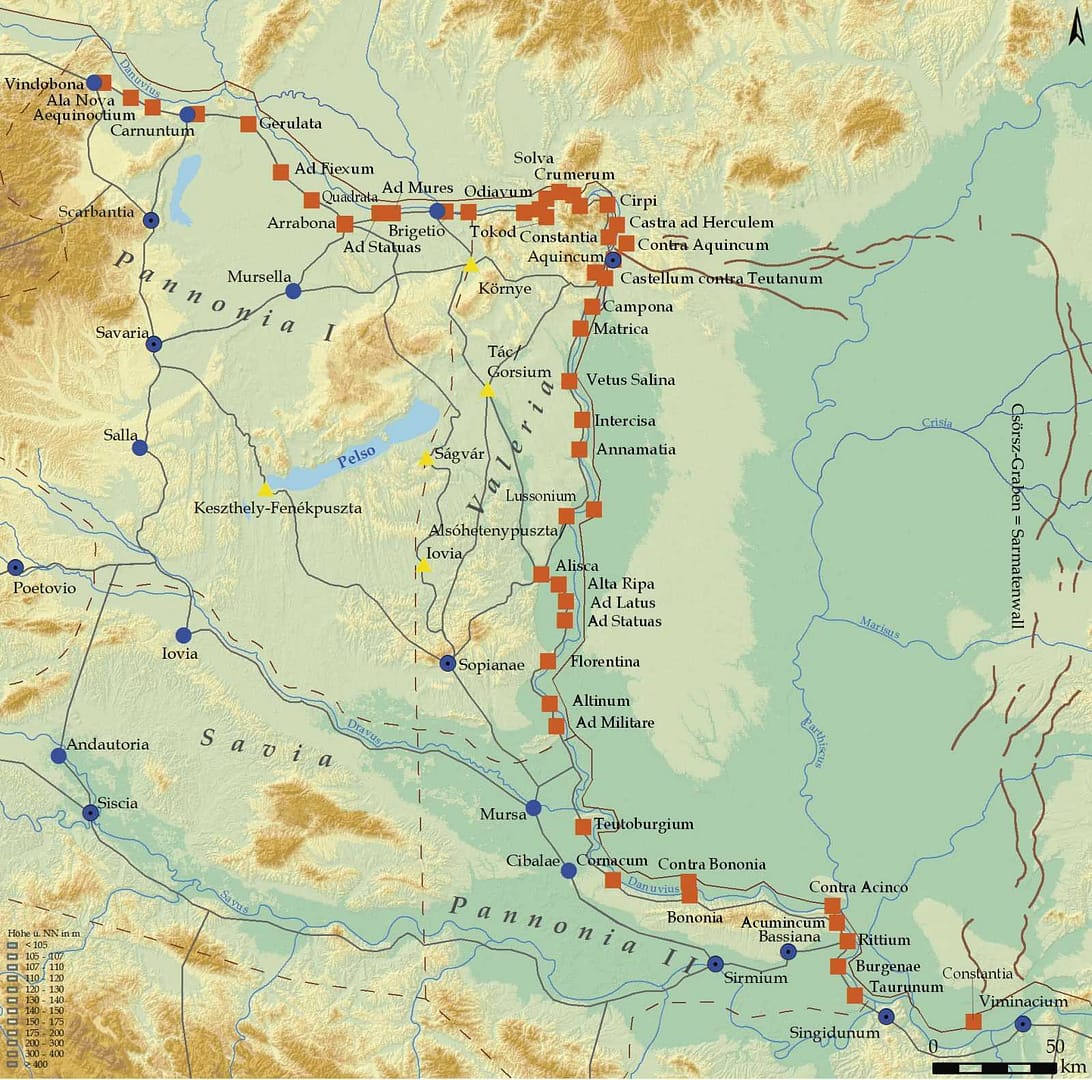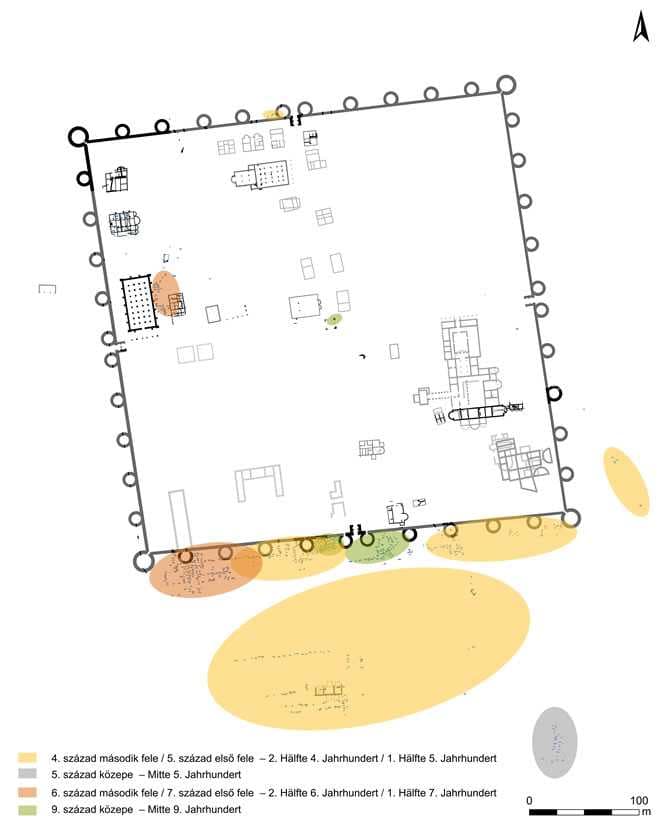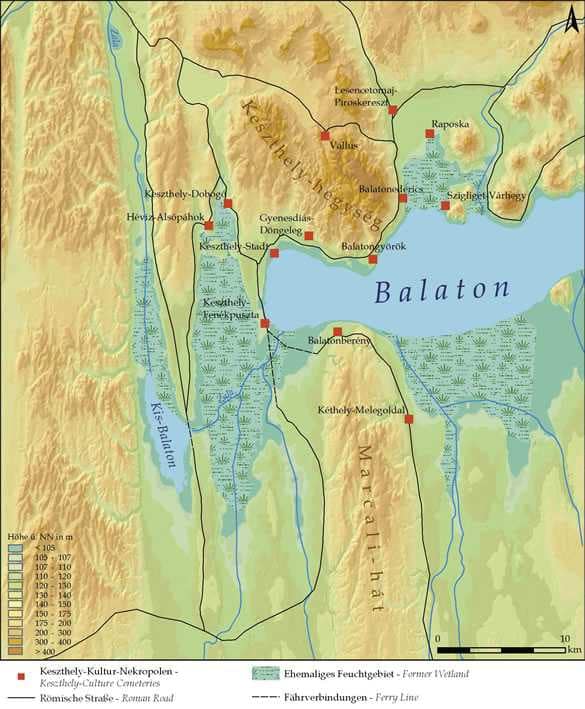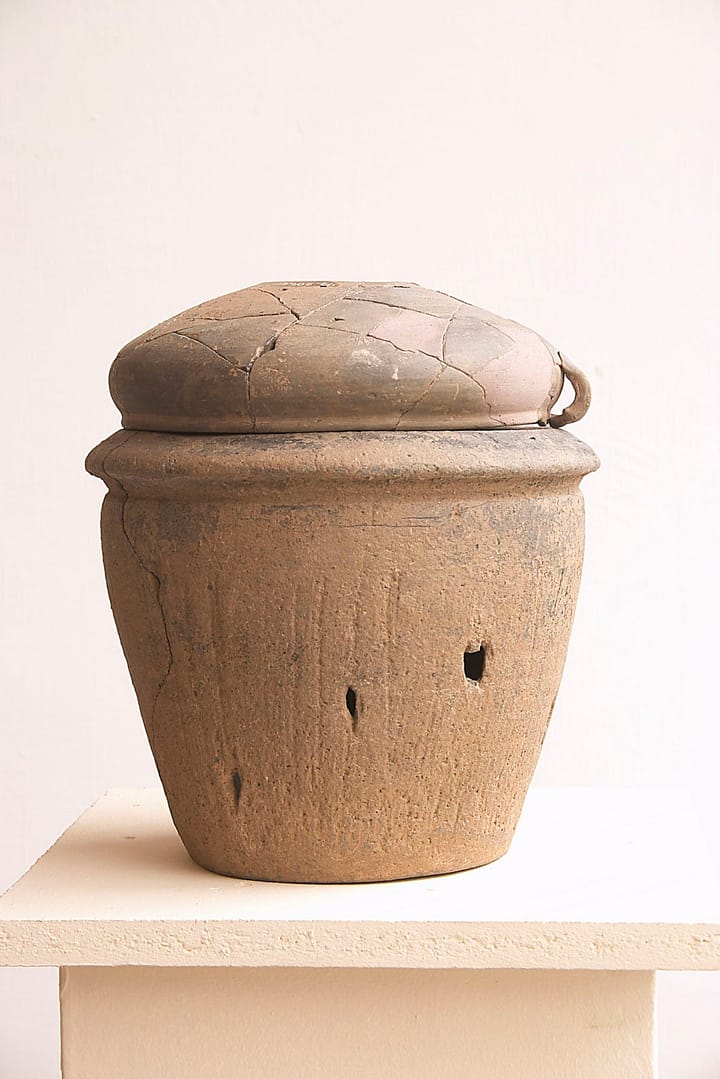Fifteen centuries of history
The walls and round towers of Fenékpuszta fortification cover an area of 15 hectares.
Three of its gates have been discovered. The fourth gate could have been situated at the eastern wall. The inner buildings had stood along the axis of the roads connecting the gates: a Horreum/Granary (15), Principia/Governor’s building(3), Praetorium/Governor’s home (4), representation buildings (A, 4, 23), simple economic and resident (5-13), also bathing buildings (24-25). The vestiges of a tetrapylon/ triumphal arch have emerged at the crossing of the two main roads (22) as well.
Geophysical surveys have revealed that the whole inner area of the fortification was built in. It was built in the second third of the 4th century, but there is no certainty as to which emperor its construction belongs to. The fortification suffered several attacks, research relates them to Barbarian campaigns known from written sources. The fortification remained in use after the province had been abandoned (5th-7th centuries): by a Christian community of Late Antique culture. Their artefacts constitute the basis of the so-called Keszthely culture. No traces of settlement occurred in the fortification from the second third of the 7th century, however in the 9th century some parts of it were settled in again. A German-Hungarian research program and a German-Hungarian excavation aimed to investigate the changes after the Roman period. A new series, Castellum Pannonicum Pelsonense is publishing the results of the project.
Keszthely-Fenékpuszta at the western pocket of Lake Balaton is one of the most significant sites in Hungary
As concerns the Late Roman period and the subsistence of its early Christian and Antique traditions until the 9th century. In the middle of the 4th century AD, a fortification of 15 hectares was built here with 44 towers and massive walls. The interior of the fortification included warehouses, baths, administrative and representative buildings. An extensive necropolis lay south from the fortification, used for burials from the construction of the fortification till the 9th century.
Research assumes that a Roman community could have still persisted in the territory after the end of the Roman Age (from the middle of the 5th century).
Such archaeological remains occur in this Christian group’s assemblages who had preserved their Antique culture and their relations in the following centuries, despite the waves of Migration sweeping over the Pannonian area with Huns followed by Eastern Goths, Heruli, Longobards and Avars. Exceptionally rich assemblages from the middle of the 6th century and an early Christian basilica prove the existence of this Christian community – known as the Keszthely Culture in archaeology. For about hundred years the fortification became uninhabited from the middle of the 7th century, but it regained its significance and was taken into possession by the Karoling Empire from the beginning of the 9th century.
Pannonia and Keszthely-Fenékpuszta
The Roman province of Pannonia, established in the 1st century AD, stretched across present-day western Hungary to the Danube in the east, the Sava in the south, and the Eastern Alps in the west.
Following the administrative and military reforms of the Roman Empire in the late 3rd century, Pannonia was divided into four provinces. At this time, numerous new fortifications were built, and older ones refurbished along the Danube frontier as well as in the interior of the province.Keszthely-Fenékpuszta belongs to these new foundations of the 4th century. In Late Antiquity, the site was located on a headland jutting out into the then much larger Lake Balaton. The fort was rectangular in plan, with massive defensive walls and towers. The castrum was integrated in the major road network that led west-southwards from the Danube frontier.
It served as a logistical centre, supplying the army with cereals, but, like many Roman towns, it also had prestigious buildings such as a triumphal arch and public baths. Keszthely-Fenékpuszta is one of the few sites known so far in Pannonia to have evidence of an occupation beyond in the mid-5th century, i.e. after the Roman province was abandoned. Its inhabitants were in close contact with the Mediterranean world, they maintained their stone buildings and even built new ones until the 6th century. The ruins of the castrum were visible above ground up to the 18th century and the area it occupied was not built on.
Archaeological research of the Late Roman fortification
Burials at Keszthely-Fenékpuszta (4th-9th centuries)
The population of the fortification usually buried their dead outside the walls.
The population of the fortification usually had interments outside the walls, however since the end of the 19th century cemeteries and cemetery sections have emerged further from the fortification. Thus far three periods have yielded interments: the Late Roman period (4th-5th centuries), the early Middle Ages (Keszthely culture: 6th-7th centuries), and the Karoling Age (9th century). There arises the fundamental question: whether continuity could exist relating to the different burial groups, that is, there might be subsistence beyond the middle of the 5th century, or else, migrants could start a new life within the fortification after 568 – the fall of the Avars. Optionally, the population that had existed here was filled up with new migrants.
A 4. századi új alapítások közé tartozik Keszthely-Fenékpuszta, egy négyszögletes alaprajzú castrum négy kapuval. A római korban magasabb vízállású Balaton egyik félszigetének déli végében feküdt, egy, a dunai limestől a birodalom belseje felé észak-déli vezető út mentén.
Keszthely-Fenékpuszta eddig azon kevés lelöhelyek egyike Pannoniában, ahol a provincia feladása után, az 5. század közepén túli római kontinuitás mutatható ki. A castrum lakói szoros kapcsolatokat ápoltak a Földközi-tengeri térséggel, karban tartották az épületeket és a 6. századig újakat is emeltek. Az erőd romjai a 18. századig még láthatók voltak a földfelszínen is, területe a modern korban nem épült be.
Keszthely Culture (6th-9th centuries)
The exploration of the large Migration period burial fields about the Keszthely region
Vilmos Lipp began the exploration of the large Migration period burial fields about Keszthely region at Fenékpuszta, Hévíz-Alsópáhok, Keszthely-Dobogó and Keszthely. Later, only Ilona Kovrig conducted excessive excavations in these sites from 1948 to1961. Their work raised the people of Keszthely culture from oblivion, a culture of various ethnic groups who lived in the western pocket of Lake Balaton until the fall of the Avars. Present research calls the archaeological remains of a Christian community of Late Antique culture as Keszthely Culture, which can primarily be defined according to the artefacts of the female graves: typically basket-like earrings, disk fibulae, bracelets and clothing-pins.
Male graves rarely contain metal dressing objects, then these are usually parts of the belt suite, or knives, and as opposed to contemporaneous Avar interments, graves lack weapon goods. Also typical, that in its early period it features Western-germanic type fibulae (S-, and bridle fibulae), and in its later period it does Avar-type cast bronze belt suites.
Prehistoric traces at Keszthely-Fenékpuszta
Fenékpuszta was constantly and densely inhabited during the Neolithic and Copper Age
Fenékpuszta was constantly and densely inhabited during the Neolithic and Copper Age due to the excellent conditions for living in the area. Already by the Middle Neolithic period it had been recognised as a site of strategic importance as a crossing point for Lake Balaton. During the Late Neolithic period large settlements were established at both the Fenékpuszta and Balatonhídvég crossings. There are known sites from this area dating to the Early and Late Bronze Age, but the most significant population increase took place in the Late Copper Age.
In the area of Fenékpuszta, there are cremation graves known to date from the Early and Middle Bronze Age
In the surroundings of Keszthely, the highest settlement density in prehistoric times was reached in the Late Bronze Age, while the strait at Fenékpuszta yielded only sparse finds, perhaps because the crossing site at Balatonmagyaród was preferred to Fenékpuszta. In the Early Iron Age, sites at the western part of Lake Balaton decreased significantly in comparison to the Late Bronze Age, and now appeared mainly in the Keszthely surroundings. This phenomenon may be due to the increasing role of the strategically important Keszthely-Fenékpuszta crossing point. At the end of the Late Iron Age, circa 100 BC, the Celts settled at the eastern, middle part of the pre-existing fortification. Their archaeological bequest is known from their quondam manor and their burials.
A mai kutatás egy késő antik kultúrájú, keresztény közösség régészeti emlékeit nevezi Keszthely-kultúrának, ami elsősorban a női sírok leletei alapján definiálható: Jellemzői a kosaras fülbevalók, korongfibulák, karperecek és ruhatűk. A férfi sírokban ritkábban vannak fém viseleti tárgyak, többnyire övgarnitúra részei, valamint kések, de az egykorú avar temetkezésekkel ellentétben fegyvermelléklet nincs a sírokban. További jellemzői a korai korszakban nyugati-germán típusú fibulák (s-, és kengyelfibulák), a késői korszakban avar típusú öntött bronzövgarnitúrák.
A 4. századi új alapítások közé tartozik Keszthely-Fenékpuszta, egy négyszögletes alaprajzú castrum négy kapuval. A római korban magasabb vízállású Balaton egyik félszigetének déli végében feküdt, egy, a dunai limestől a birodalom belseje felé észak-déli vezető út mentén. Keszthely-Fenékpuszta eddig azon kevés lelőhelyek egyike Pannóniában, ahol a provincia feladása után, az 5. század közepén túli római kontinuitás mutatható ki. A castrum lakói szoros kapcsolatokat ápoltak a Földközi-tengeri térséggel, karban tartották az épületeket és a 6. századig újakat is emeltek. Az erőd romjai a 18. századig még láthatók voltak a földfelszínen is, területe a modern korban nem épült be.
